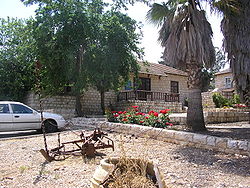Ilaniya
|
Ilaniya אִילָנִיָּה |
|
|---|---|
 |
|
| Coordinates: 32°45′30″N 35°24′7″E / 32.75833°N 35.40194°ECoordinates: 32°45′30″N 35°24′7″E / 32.75833°N 35.40194°E | |
| District | Northern |
| Council | Lower Galilee |
| Affiliation | Agricultural Union |
| Founded | 1899 |
| Founded by | Jewish Colonization Association |
| Population (2015) | 484 |
Ilaniya (Hebrew: אִילָנִיָּה) is a moshav in northern Israel. Also known as Sejera, after the adjacent Arab village al-Shajara, it was the first Jewish settlement in the Lower Galilee and played an important role in the Jewish settlement of the Galilee from its early years until the 1948 Arab–Israeli War. It falls under the jurisdiction of Lower Galilee Regional Council, and had a population of 484 in 2015.
A Jewish town was located in the surrounding hills during the period of the Talmud and Mishnah.
The agricultural colony of Sejera, later Ilaniya, was established in 1900-1902 on land purchased by Baron Edmond James de Rothschild which was transferred to the management of the Jewish Colonization Association (JCA/ICA) in 1899. Also in 1899, JCA bought additional land for its planned colony. The first settlers were residents of Safed, a group of immigrants from Kurdistan and eight families of Subbotniks, Russian Christians who had converted to Judaism, among them the Dubrovin family.
The small settlement founded by JCA had two sections, a sharecroppers' colony for more experienced farmers, and a training farm for unskilled workers. The former consisted of a short street with private houses on both sides with garden plots in front and sheds at the back.
The training farm was located slightly higher up the slope, with a yard enclosed by a wall and single rooms for workers. The overall concept came from JCA official Chaim Margalioth Kalvarisky. The JCA's purpose was to help settle the land with professional Jewish farmers, agriculture being seen as a morally as well as economically sound activity. Unwilling to run their project as a charity organisation in the style of Baron de Rothschild, the JCA leaders in Paris expected the training farm to be self-sufficient and to generate profit. When this did not happen, they replaced Kalvarisky in 1901 with the young agronomist Eliyahu Krause. Since the farm continued losing money, the JCA started in 1906 a process of reducing the administered training farm and gradually transferring its allocated land to the sharecroppers.
...
Wikipedia

